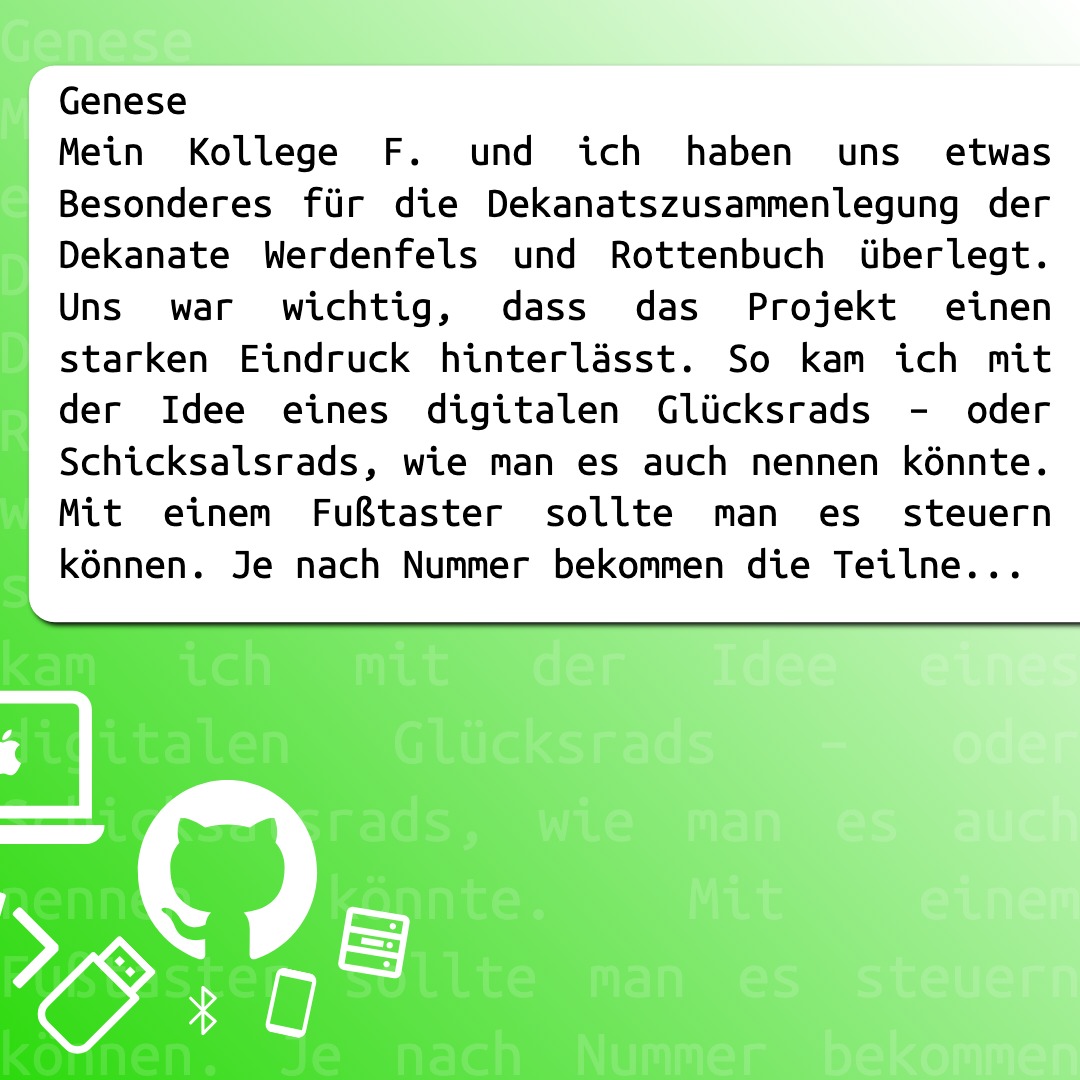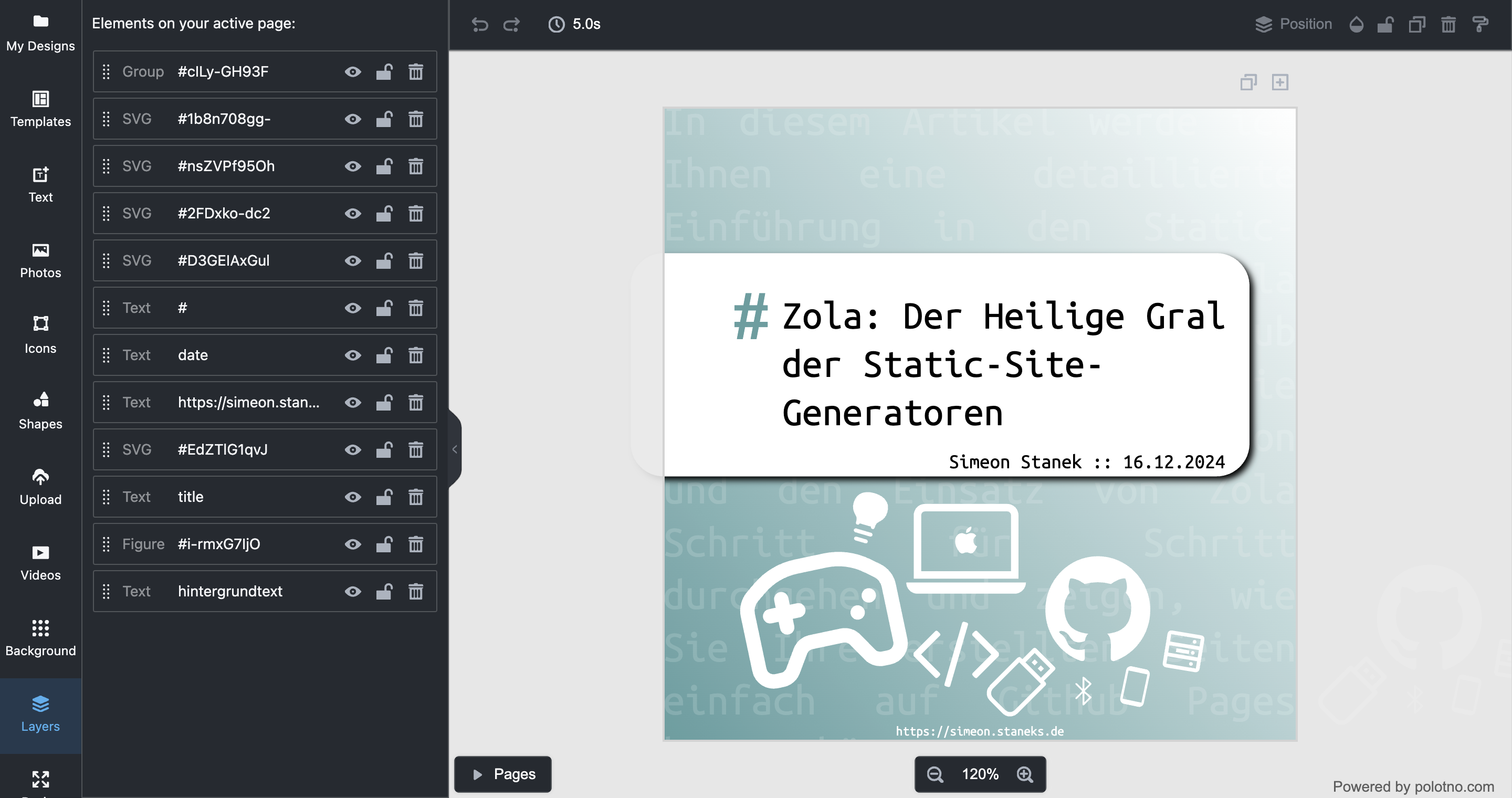Automatic Cover Image Generation for Zola Blogs with Bun, TypeScript and Polotno.
Table of Contents
- The Genesis: Why Generate Images Automatically?
-
The Technology: Zola, Bun, TypeScript, and Polotno
- Technical Solution Overview
- The Deployment Script
- The Image Generator: Under the Hood
- The Process in Detail
- 1. Reading Data from RSS Feed
- 2. Individual Color Scheme per Article
- 3. Template Customization for Each Article
- 4. Image Generation with Polotno
- 5. Storing Images in Blog Structure
- 6. Multilingual Support
- Zola Configuration for Image Usage
- The Benefits of Automation
- Conclusion
The Genesis: Why Generate Images Automatically?
I love podcasts and listen to them a lot, which is why I have Antennapod installed on my Android phone. It's my favorite podcatcher, which occasionally doubles as a feed reader. I noticed that simple RSS feeds lack cover images, and I wanted to change that for my feed, plus I needed preview images for social media anyway. Every blog post needs an attractive title image to grab attention on social media, RSS feeds, and the website itself. However, manually creating individual images for each article is time-consuming and requires significant effort.
I decided to automate this process: A script that automatically generates various images for different platforms from my blog post metadata - with consistent design but individual elements based on each article's content.








The Technology: Zola, Bun, TypeScript, and Polotno
Technical Solution Overview
My solution uses the following technologies:
- Zola as static site generator for the blog and RSS feed server
- Bun as JavaScript runtime (faster than Node.js)
- TypeScript for programming logic
- Polotno for programmatic image generation
- RSS feeds as data source for post information
The system generates four different image formats for each blog post:
- An OG image for social media previews
- An Instagram format 1
- An Instagram format 2
- A feed image for RSS readers
Additionally, all images are automatically created for different language versions of the blog.
The Deployment Script
Here's the bash script that starts the entire process:
#!/bin/bash
# Blog publishing script
cd /Users/simeonstanek/Apps/BLOG-Homepage/simeonsblog/scripts
# start the server
zola serve --port 1234 &
sleep 5
# run the generator
bun run index.ts
# stop the server
kill $(lsof -t -i:1234)
# commit all changes
cd /Users/simeonstanek/Apps/BLOG-Homepage/simeonsblog
git pull
git add *
git commit -m "update content on $(date)"
git push
This script performs the following steps:
- Changes to the scripts directory
- Starts the Zola server in the background (for RSS feed)
- Waits 5 seconds for the server to fully start
- Runs the TypeScript script with Bun
- Stops the Zola server
- Commits changes and pushes to Git repository
The Image Generator: Under the Hood
Now let's look at the core of the solution - the TypeScript script that does the actual work:
import { hash } from "bun";
const fs = require("fs");
const { DOMParser } = require("xmldom");
const { createInstance } = require("polotno-node");
// Main function controlling the entire process
async function run(x, lang) {
let titles = [];
let dates = [];
let urls = [];
let content = [];
let languages = "de";
// Fetch and process RSS feed
const data = fetch(lang)
.then((response) => response.text())
.then((str) => {
let parser = new DOMParser();
let xml = parser.parseFromString(str, "text/xml");
let items = xml.getElementsByTagName("item");
languages = xml.getElementsByTagName("language")[0].childNodes[0].nodeValue;
// Extract information from RSS feed
for (let o = 0; o < items.length; o++) {
titles.push(items[o].getElementsByTagName("title")[0].childNodes[0].nodeValue);
let date = new Date(items[o].getElementsByTagName("pubDate")[0].childNodes[0].nodeValue);
let options = { year: "numeric", month: "long", day: "numeric" };
let formattedDate = date.toLocaleDateString("de-DE", options);
dates.push(formattedDate);
let url = items[o].getElementsByTagName("link")[0].childNodes[0].nodeValue;
url = url.split("/");
url = url[url.length - 3] + "/" + url[url.length - 2];
urls.push(url);
let description = items[o].getElementsByTagName("description")[0].childNodes[0].nodeValue;
if (description.length > 500) {
description = description.substring(0, 500) + "...";
}
description = description.replace(/<[^>]*>?/gm, "");
content.push(description);
}
// Adjust templates and generate images
for (let k = 0; k < titles.length; k++) {
let template = JSON.parse(fs.readFileSync("data" + "/" + x, "utf8"));
for (let i = 0; i < template.pages.length; i++) {
template.pages[i].background = "linear-gradient(228deg,white 0%," + getRGB(titles[k]) + " 100%)";
for (let j = 0; j < template.pages[i].children.length; j++) {
if (template.pages[i].children[j].name == "title") {
template.pages[i].children[j].text = titles[k];
}
if (template.pages[i].children[j].name == "date") {
template.pages[i].children[j].text = "Simeon Stanek :: " + dates[k];
}
if (template.pages[i].children[j].name == "hintergrundtext") {
template.pages[i].children[j].text = content[k];
}
}
}
exporter(template, k, urls[k], x, languages);
}
});
// Function for image generation and storage
async function exporter(template, i, url, x, languages) {
fs.mkdirSync("../content/" + url + "/images/" + languages, { recursive: true });
if (x == "ogimage.json" && !fs.existsSync("../content/" + url + "/images/" + languages + "/preview.jpg")) {
let instance = await createInstance({ key: "[your-api-key]" });
let pdfBase64 = await instance.jsonToImageBase64(template, { mimeType: "image/jpeg" });
fs.writeFileSync("../content/" + url + "/images/" + languages + "/preview.jpg", pdfBase64, "base64");
instance.close();
}
if (x == "instagram1.json" && !fs.existsSync("../content/" + url + "/images/" + languages + "/instagram1.jpg")) {
let instance = await createInstance({ key: "[your-api-key]" });
let pdfBase64 = await instance.jsonToImageBase64(template, { mimeType: "image/jpeg" });
fs.writeFileSync("../content/" + url + "/images/" + languages + "/instagram1.jpg", pdfBase64, "base64");
instance.close();
}
if (x == "instagram2.json" && !fs.existsSync("../content/" + url + "/images/" + languages + "/instagram2.jpg")) {
let instance = await createInstance({ key: "[your-api-key]" });
let pdfBase64 = await instance.jsonToImageBase64(template, { mimeType: "image/jpeg" });
fs.writeFileSync("../content/" + url + "/images/" + languages + "/instagram2.jpg", pdfBase64, "base64");
instance.close();
}
if (x == "feed.json" && !fs.existsSync("../content/" + url + "/images/" + languages + "/feed.jpg")) {
let instance = await createInstance({ key: "[your-api-key]" });
let pdfBase64 = await instance.jsonToImageBase64(template, { mimeType: "image/jpeg" });
fs.writeFileSync("../content/" + url + "/images/" + languages + "/feed.jpg", pdfBase64, "base64");
instance.close();
}
}
}
// Function to generate RGB color from string
function getRGB(str) {
let hashed = hash(str);
let result = hashed.toString(16).substring(0, 6);
return "#" + result;
}
// Main function for image generation
async function generate() {
run("ogimage.json", "http://127.0.0.1:1234/rss.xml");
setTimeout(() => {
run("instagram1.json", "http://127.0.0.1:1234/rss.xml");
}, 1000);
setTimeout(() => {
run("instagram2.json", "http://127.0.0.1:1234/rss.xml");
}, 1000);
setTimeout(() => {
run("feed.json", "http://127.0.0.1:1234/rss.xml");
}, 1000);
setTimeout(() => {
run("ogimage.json", "http://127.0.0.1:1234/en/rss.xml");
}, 1000);
setTimeout(() => {
run("instagram1.json", "http://127.0.0.1:1234/en/rss.xml");
}, 1000);
setTimeout(() => {
run("instagram2.json", "http://127.0.0.1:1234/en/rss.xml");
}, 1000);
setTimeout(() => {
run("feed.json", "http://127.0.0.1:1234/en/rss.xml");
}, 1000);
}
generate();
The Process in Detail
1. Reading Data from RSS Feed
The script starts by fetching the blog's RSS feed and extracting relevant information:
- Post titles
- Publication dates (formatted)
- Post URLs
- Brief descriptions (truncated to 500 characters)
The feed is parsed as XML and data is stored in arrays.
2. Individual Color Scheme per Article
A clever feature of the script is automatic color generation for each article:
function getRGB(str) {
let hashed = hash(str);
let result = hashed.toString(16).substring(0, 6);
return "#" + result;
}
This function generates a hash value from the article title and converts it to a HEX color code. This gives each article a unique but consistent color scheme that remains the same with each run.
3. Template Customization for Each Article
For each image type (OG image, Instagram, Feed), there's a JSON template in the "data" directory. These templates are dynamically adjusted for each article. I created the templates using Polotno Studio:
- The background gets an individual color gradient
- The title is inserted
- The date with author name is added
- A content excerpt is used as background text Make sure the layers in your JSON templates match the names referenced in the TypeScript script.

4. Image Generation with Polotno
The customized templates are converted to JPEG images using Polotno:
let instance = await createInstance({
key: "[your-api-key]",
});
let pdfBase64 = await instance.jsonToImageBase64(template, {
mimeType: "image/jpeg",
});
5. Storing Images in Blog Structure
The generated images are stored in a structured directory tree:
/content/[article-name]/images/[language]/[image-type].jpg
6. Multilingual Support
The script automatically generates images for all language versions of the blog (in this example, German and English).
Zola Configuration for Image Usage
For Zola to properly use the generated images, here's an example of the corresponding template configuration:
{% if page.path %}
<meta property="og:image" content="{{config.base_url | safe}}{{ page.path | safe }}/images/{{lang}}/preview.jpg" />
<meta property="og:logo" content="{{config.base_url | safe}}{{ page.path | safe }}/images{{lang}}/preview.jpg" />
<!-- twitter card -->
<meta name="twitter:card" content="summary_large_image">
<meta name="twitter:image" content="{{config.base_url | safe}}{{ page.path | safe }}images/{{lang}}/preview.jpg">
{% elif config.extra.favicon %}
<meta property="og:image" content="{{ config.extra.favicon }}" />
{% endif %}
The Benefits of Automation
This solution offers several advantages:
- Consistent Design: All images follow the same design scheme, strengthening brand identity (if I had one).
- Individual Touch: Each article still gets its own color scheme and content as visual elements.
- Time Savings: Image generation happens before article publication by simply running the deployment script.
- Multilingual Support: All language versions are supported without additional effort.
- Complete Integration: Through Git integration, all changes are published immediately.
Conclusion
With this combination of Zola, Bun, TypeScript, and Polotno, I've found an elegant solution to improve my blog workflow. The automatic image generation ensures that each article is visually appealing without requiring additional effort.
The solution is flexible and can be easily adapted to other requirements - whether by changing templates, adding more image formats, or adjusting visual elements.
If you want to use this approach for your own blog, make sure to get your own Polotno API key and adjust the templates to your own design.